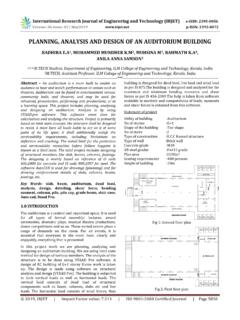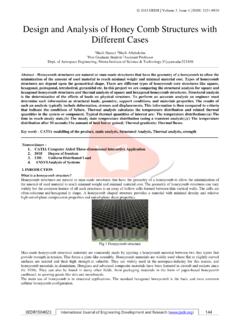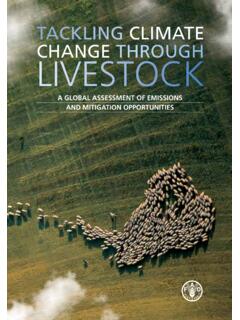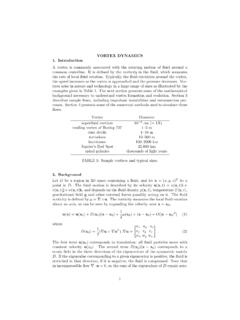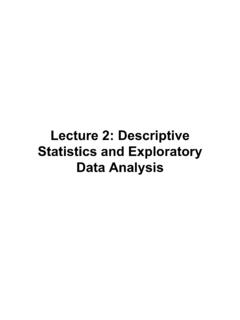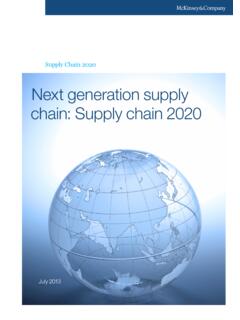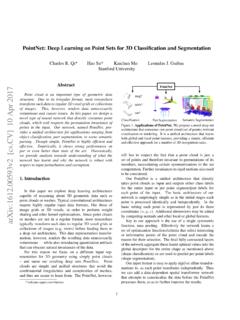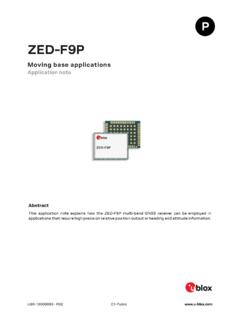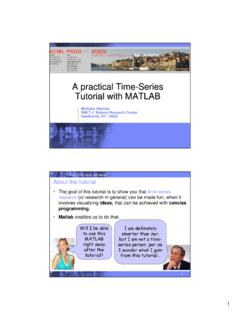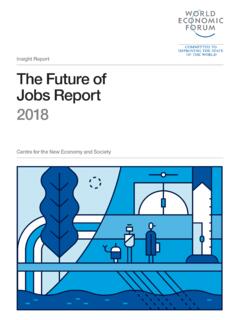Transcription of IEEE TRANSACTIONS ON PATTERN ANALYSIS AND MACHINE ...
1 IEEE TRANSACTIONS ON PATTERN ANALYSIS AND MACHINE INTELLIGENCE1 Deep Learning for 3D Point Clouds: A SurveyYulan Guo , Hanyun Wang , Qingyong Hu , Hao Liu , Li Liu, and Mohammed BennamounAbstract Point cloud learning has lately attracted increasing attention due to its wide applications in many areas, such as computervision, autonomous driving, and robotics. As a dominating technique in AI, deep learning has been successfully used to solve various2D vision problems. However, deep learning on point clouds is still in its infancy due to the unique challenges faced by the processingof point clouds with deep neural networks. Recently, deep learning on point clouds has become even thriving, with numerous methodsbeing proposed to address different problems in this area.
2 To stimulate future research, this paper presents a comprehensive review ofrecent progress in deep learning methods for point clouds. It covers three major tasks, including 3D shape classification, 3D objectdetection and tracking, and 3D point cloud segmentation. It also presents comparative results on several publicly available datasets,together with insightful observations and inspiring future research Terms deep learning, point clouds, 3D data, shape classification, shape retrieval, object detection, object tracking, scene flow,instance segmentation, semantic segmentation, part INTRODUCTIONWITHthe rapid development of 3D acquisition tech-nologies, 3D sensors are becoming increasingly avail-able and affordable, including various types of 3D scanners,LiDARs, and RGB-D cameras (such as Kinect, RealSense andApple depth cameras) [1].
3 3D data acquired by these sensorscan provide rich geometric, shape and scale information [2],[3]. Complemented with 2D images, 3D data provides anopportunity for a better understanding of the surroundingenvironment for machines. 3D data has numerous appli-cations in different areas, including autonomous driving,robotics, remote sensing, and medical treatment [4].3D data can usually be represented with different for-mats, including depth images, point clouds, meshes, andvolumetric grids. As a commonly used format, point cloudrepresentation preserves the original geometric informationin 3D space without any discretization. Therefore, it is thepreferred representation for many scene understanding re-lated applications such as autonomous driving and , deep learning techniques have dominated manyresearch areas, such as computer vision, speech recognition,and natural language processing.
4 However, deep learningon 3D point clouds still face several significant challenges[5], such as the small scale of datasets, the high dimensional-ity and the unstructured nature of 3D point clouds. On thisbasis, this paper focuses on the ANALYSIS of deep learningmethods which have been used to process 3D point learning on point clouds has been attracting moreand more attention, especially in the last five years. Sev-eral publicly available datasets are also released, such as Y Guo and H. Liu are with the School of Electronics and CommunicationEngineering, Sun Yat-sen University, China. H. Wang is with the Schoolof Surveying and Mapping, Information Engineering University, Hu is with Department of Computer Science, University of Oxford,UK.
5 L. Liu is with the College of System Engineering, National Universityof Defense Technology, China, and also with the Center for MACHINE Visionand Signal ANALYSIS , University of Oulu, Finland. M. Bennamoun iswith the Department of Computer Science and Software Engineering, theUniversity of Western Australia, Australia. *Y. Guo, H. Wang, Q. Hu and H. Liu have equal contribution to this workand are co-first authors. Corresponding author: Yulan Guo [6], ScanObjectNN [7], ShapeNet [8], PartNet [9],S3 DIS [10], ScanNet [11], Semantic3D [12], ApolloCar3D[13], and the KITTI Vision Benchmark Suite [14], [15]. Thesedatasets have further boosted the research of deep learningon 3D point clouds, with an increasingly number of methodsbeing proposed to address various problems related to pointcloud processing, including 3D shape classification, 3D ob-ject detection and tracking, 3D point cloud segmentation,3D point cloud registration, 6-DOF pose estimation, and 3 Dreconstruction [16], [17], [18].
6 Few surveys of deep learningon 3D data are also available, such as [19], [20], [21], [22].However, our paper is the first to specifically focus ondeep learning methods for point cloud understanding. Ataxonomy of existing deep learning methods for 3D pointclouds is shown in Fig. with the existing literatures, the major contri-butions of this work can be summarized as follows:1)To the best of our knowledge, this is thefirstsur-vey paper to comprehensively cover deep learningmethods for several important point cloud under-standing tasks, including 3D shape classification, 3 Dobject detection and tracking, and 3D point )As opposed to existing reviews [19], [20], we specif-ically focus on deep learning methods for3D pointcloudsrather than all types of 3D )This paper covers themost recent and advanced pro-gressesof deep learning on point clouds.
7 There-fore, it provides the readers with the )Comprehensivecomparisons of existing methodsonseveral publicly available datasets are provided( , in Tables 2, 3, 4, 5), with brief summaries andinsightful discussions being structure of this paper is as follows. Section 2introduces the datasets and evaluation metrics for therespective tasks. Section 3 reviews the methods for 3 Dshape classification. Section 4 provides a survey of existingmethods for 3D object detection and tracking. Section 5 [ ] 23 Jun 2020 IEEE TRANSACTIONS ON PATTERN ANALYSIS AND MACHINE INTELLIGENCE2 Deep Learning on 3D Point Clouds3D Object Detection and Tracking3D Shape Classification3D Point Cloud SegmentationMulti-view based Methods (Section )Point-based Methods(Section ) Object Detection(Section )Object Tracking(Section )Scene Flow Estimation(Section )Semantic Segmentation(Section )Instance Segmentation(Section )Part Segmentation(Section )Pointwise MLP MethodsConvolution-based MethodsGraph-based MethodsHierarchical Data Structure-based MethodsOther MethodsRegion Proposal-based Methods (Section )Single Shot Methods(Section )Projection-based Methods (Section )Discretization-based Methods (Section )
8 Multi-view MethodsSegmentation-based MethodsFrustum-based MethodsOther MethodsBEV-based MethodsDiscretization-based MethodsOther MethodsMulti-view RepresentationSpherical RepresentationDense DiscretizationRepresentationHybid Methods (Section )Pointwise MLP MethodsPoint Convolution MethodsRNN-based MethodsGraph-based MethodsProposal-based MethodsProposal-free MethodsPoint-based MethodsVolumetric-based Methods (Section )Sparse DiscretizationRepresentationPoint-based Methods (Section )Fig. 1: A taxonomy of deep learning methods for 3D point a review of methods for point cloud segmentation,including semantic segmentation, instance segmentation,and part segmentation. Finally, Section 6 concludes thepaper. We also provide a regularly updated project page on: DatasetsA large number of datasets have been collected toevaluate the performance of deep learning algorithms fordifferent 3D point clouds applications.
9 Table 1 lists sometypical datasets used for 3D shape classification, 3D objectdetection and tracking, and 3D point cloud segmentation. Inparticular, the attributes of these datasets are also 3D shape classification, there are two types ofdatasets: synthetic datasets [6], [8] and real-world datasets[7], [11]. Objects in the synthetic datasets are complete,without any occlusion and background. In contrast, objectsin the real-world datasets are occluded at different levelsand some objects are contaminated with background 3D object detection and tracking, there are two typesof datasets: indoor scenes [11], [25] and outdoor urbanscenes [14], [28], [30], [31]. The point clouds in the indoordatasets are either converted from dense depth maps orsampled from 3D meshes.
10 The outdoor urban datasets aredesigned for autonomous driving, where objects are spa-tially well separated and these point clouds are 3D point cloud segmentation, these datasets are ac-quired by different types of sensors, including Mobile LaserScanners (MLS) [15], [34], [36], Aerial Laser Scanners (ALS)[33], [38], static Terrestrial Laser Scanners (TLS) [12], RGB-D cameras [11] and other 3D scanners [10]. These datasetscan be used to develop algorithms for various challengesincluding similar distractors, shape incompleteness, andclass Evaluation MetricsDifferent evaluation metrics have been proposed to testthese methods for various point cloud understanding 3D shape classification,Overall Accuracy(OA) andmeanclass accuracy(mAcc) are the most frequently used perfor-mance criteria.
![arXiv:0706.3639v1 [cs.AI] 25 Jun 2007](/cache/preview/4/1/3/9/3/1/4/b/thumb-4139314b93ef86b7b4c2d05ebcc88e46.jpg)

![arXiv:1301.3781v3 [cs.CL] 7 Sep 2013](/cache/preview/4/d/5/0/4/3/4/0/thumb-4d504340120163c0bdf3f4678d8d217f.jpg)
![@google.com arXiv:1609.03499v2 [cs.SD] 19 Sep 2016](/cache/preview/c/3/4/9/4/6/9/b/thumb-c349469b499107d21e221f2ac908f8b2.jpg)






